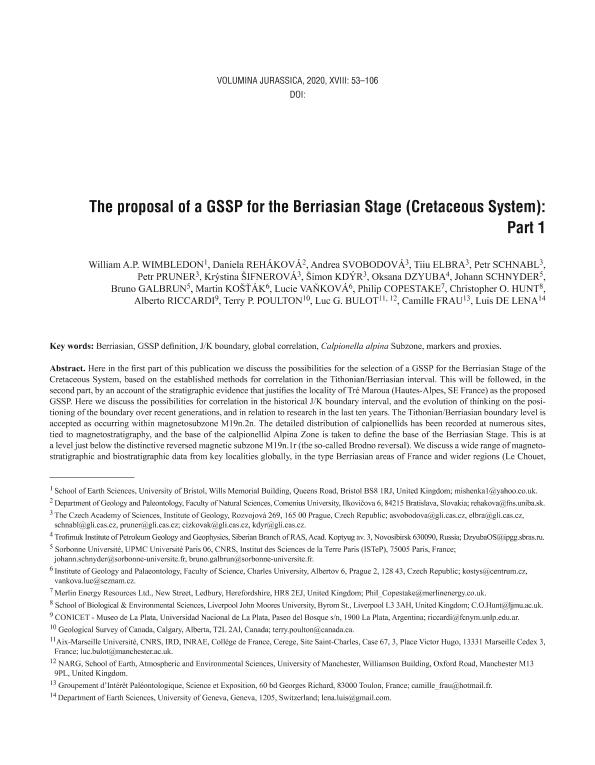Artículo
The proposal of a GSSP for the Berriasian Stage (Cretaceous System): Part 1
Wimbledon, William A. P.; Reháková, Daniela; Svobodová, Andrea; Elbra, Tiiu; Schnabl, Petr; Pruner, Petr; Šifnerová, Krýstina; Kdýr, Šimon; Dzyuba, Oksana; Schnyder, Johann; Galbrun, Bruno; Košťák, Martin; Vaňková, Lucie; Copestake, Philip; Hunt, Christopher O.; Riccardi, Alberto Carlos ; Poulton, Terry P.; Bulot, Luc G.; Frau, Camille; De Lena, Luis
; Poulton, Terry P.; Bulot, Luc G.; Frau, Camille; De Lena, Luis
 ; Poulton, Terry P.; Bulot, Luc G.; Frau, Camille; De Lena, Luis
; Poulton, Terry P.; Bulot, Luc G.; Frau, Camille; De Lena, Luis
Fecha de publicación:
03/2020
Editorial:
National Research Institute. Polish Geological Institute
Revista:
Volumina Jurassica
ISSN:
1731-3708
Idioma:
Inglés
Tipo de recurso:
Artículo publicado
Clasificación temática:
Resumen
Here in the first part of this publication we discuss the possibilities for the selection of a GSSP for the Berriasian Stage of the Cretaceous System, based on the established methods for correlation in the Tithonian/Berriasian interval. This will be followed, in the second part, by an account of the stratigraphic evidence that justifies the locality of Tré Maroua (Hautes-Alpes, SE France) as the proposed GSSP. Here we discuss the possibilities for correlation in the historical J/K boundary interval, and the evolution of thinking on the positioning of the boundary over recent generations, and in relation to research in the last ten years. The Tithonian/Berriasian boundary level is accepted as occurring within magnetosubzone M19n.2n. The detailed distribution of calpionellids has been recorded at numerous sites, tied to magnetostratigraphy, and the base of the calpionellid Alpina Zone is taken to define the base of the Berriasian Stage. This is at a level just below the distinctive reversed magnetic subzone M19n.1r (the so-called Brodno reversal). We discuss a wide range of magnetostratigraphic and biostratigraphic data from key localities globally, in the type Berriasian areas of France and wider regions (Le Chouet, Saint Bertrand, Puerto Escaño, Rio Argos, Bosso, Brodno, Kurovice, Theodosia etc.). The characteristic datums that typify the J/K boundary interval in Tethys and its extensions are detailed, and the correlative viability of various fossil groups is discussed. The boundary level is correlated to well-known J/K sections globally, and a series of secondary markers and proxies are indicated which assist wider correlation. Particularly significant are the primary basal Berriasian marker, the base of the Alpina Subzone (marked by dominance of small Calpionella alpina, Crassicollaria parvula and Tintinopsella carpathica) and secondary markers bracketing the base of the Calpionella Zone, notably the FOs of the calcareous nannofossil species Nannoconus wintereri (just below the boundary) and the FO of Nannoconus steinmannii minor (just above). Notable proxies for the boundary are: 1) the base of the Arctoteuthis tehamaensis Zone in boreal and subboreal regions, 2) the dated base of the Alpina Subzone at 140.22 ±0.14 Ma, which also gives a precise age estimate for the system boundary; and 3) the base of radiolarian “unitary zone” 14, which is situated just above the base of the Alpina Subzone.
Palabras clave:
Berriasiano
,
GSSP
,
Correlacion global
,
Marcadores y proxis
Archivos asociados
Licencia
Identificadores
Colecciones
Articulos(CCT - LA PLATA)
Articulos de CTRO.CIENTIFICO TECNOL.CONICET - LA PLATA
Articulos de CTRO.CIENTIFICO TECNOL.CONICET - LA PLATA
Citación
Wimbledon, William A. P.; Reháková, Daniela; Svobodová, Andrea; Elbra, Tiiu; Schnabl, Petr; et al.; The proposal of a GSSP for the Berriasian Stage (Cretaceous System): Part 1; National Research Institute. Polish Geological Institute; Volumina Jurassica; 18; 1; 3-2020; 53-106
Compartir
Altmétricas



